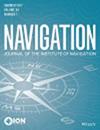基于多历元克里格的三维测绘辅助GNSS与多普勒测量融合因子图优化
IF 2
3区 地球科学
Q1 ENGINEERING, AEROSPACE
引用次数: 0
摘要
全球卫星导航系统(GNSS)信号在建筑物上的反射会降低城市峡谷中的定位性能。不同的三维(3D)地图辅助(3DMA) GNSS算法已经被提出,它们利用三维建筑模型来辅助定位。最近,基于候选的3DMA GNSS框架被应用于检测均匀间隔的分布粒子。与观测值最匹配的粒子,即成本最小的粒子,被确定为接收器位置。然而,这种粒子采样方法的计算量大,鲁棒性差。本研究采用基于kriging插值的方法对基于采样粒子的3DMA GNSS成本函数进行建模,并通过因子图优化将建模后的成本函数与多普勒测量值进行整合。回归模型可以通过稀疏分布粒子来减少计算量。在智能手机和商用级GNSS接收机上设计的实验表明,在香港和纽约市的城市峡谷中,定位性能可以实现小于10 m的均方根误差。本文章由计算机程序翻译,如有差异,请以英文原文为准。
Multi-Epoch Kriging-Based 3D Mapping-Aided GNSS and Doppler Measurement Fusion using Factor Graph Optimization
Abstract
Global navigation satellite system (GNSS) signal reflection over buildings degrades positioning performance in urban canyons. Different three-dimensional (3D) mapping-aided (3DMA) GNSS algorithms have been proposed, which utilize 3D building models to aid in positioning. Recently, the candidate-based 3DMA GNSS framework has been applied to examine evenly spaced distributed particles. The particles that best match the observed measurements, that is, with the minimum cost, are identified as the receiver location. However, such particle sampling approaches incur a high computational load and are not robust. In this study, a Kriging-based interpolation method is applied to model the cost function of a 3DMA GNSS based on sampled particles, and the modeled cost function is then integrated with Doppler measurements through factor graph optimization. The regressed model can reduce the computational load by sparsely distributing the particles. Designed experiments with smartphone and commercial-level GNSS receivers demonstrate that the positioning performance can achieve a root mean square error of less than 10 m in Hong Kong and New York City urban canyons.求助全文
通过发布文献求助,成功后即可免费获取论文全文。
去求助
来源期刊

Navigation-Journal of the Institute of Navigation
ENGINEERING, AEROSPACE-REMOTE SENSING
CiteScore
5.60
自引率
13.60%
发文量
31
期刊介绍:
NAVIGATION is a quarterly journal published by The Institute of Navigation. The journal publishes original, peer-reviewed articles on all areas related to the science, engineering and art of Positioning, Navigation and Timing (PNT) covering land (including indoor use), sea, air and space applications. PNT technologies of interest encompass navigation satellite systems (both global and regional), inertial navigation, electro-optical systems including LiDAR and imaging sensors, and radio-frequency ranging and timing systems, including those using signals of opportunity from communication systems and other non-traditional PNT sources. Articles about PNT algorithms and methods, such as for error characterization and mitigation, integrity analysis, PNT signal processing and multi-sensor integration, are welcome. The journal also accepts articles on non-traditional applications of PNT systems, including remote sensing of the Earth’s surface or atmosphere, as well as selected historical and survey articles.
 求助内容:
求助内容: 应助结果提醒方式:
应助结果提醒方式:


